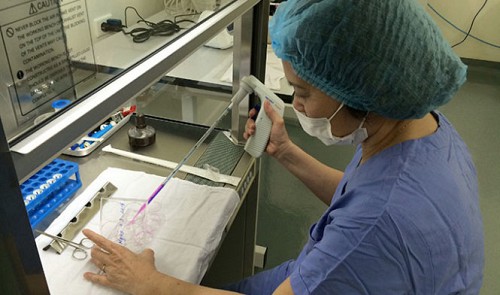Vietnamese female scientists succeed in low-cost groundbreaking eye research

Female scientists at Hanoi Medical University’s Embryology Faculty and their counterparts at the National Institute of Ophthalmology’s Cornea Faculty have successfully cultured stem cells of the peripheral areas of corneas and of epithelium in the mucous membrane, which will be used as transplants for patients with damage to the eyeball surface.
The approach, which is the first to have been attempted in the country, was conducted at a cost of VND890 million (US$41,476), much cheaper than normal.
The team’s efforts have paid off as their research proves fruitful and earned them a 2014 Kovalevskaia award, which was given away on Saturday.
The awards are given annually to outstanding female scientists for their innovative research or massive contributions to the local science arena.
According to Associate Professor Hoang Minh Chau, of the National Institute of Ophthalmology’s Cornea Faculty, the team was driven by their concern that a growing number of patients have incurred extensive damage to their eyeball surface in both their eyes and face an imminent risk of going blind.
The approaches adopted in the past are flawed and required that patients be on medication to avoid transplant rejection risks for the rest of their life.
Based on research in other countries, the team embarked on their groundbreaking work and piloted their stem cell culture in 2003.
Their hurdles included limited state funding and unavailability of certain chemicals and materials in Vietnam.
Undaunted, the team worked out alternative chemicals and materials.
Four years later, their culture of rabbits’ stem cells of the peripheral areas of corneas was a big success, with the cells and epithelium working well on the animals that sustained eye injuries.
The women made a daring move when they began their culture and transplant on humans in 2008.
The transplant’s result on the first patient treated with the approach seven years ago has remained good so far.
Associate Professor Nguyen Thi Binh, of Hanoi Medical University, said over 20 patients have received the treatment up to now.
The team has also completed paperwork to propose that the Ministry of Health adopt the pioneering treatment in many eye hospitals and clinics.
The scientists hope that they will soon be able to begin similar research which meets global standards.
What the stars mean:
★ Poor ★ ★ Promising ★★★ Good ★★★★ Very good ★★★★★ Exceptional
Latest News
More News
- Protect what’s next: towards a future free from meningococcal group B disease (December 05, 2025 | 18:00)
- New ILO report offers policy recommendations for disability inclusion (December 04, 2025 | 15:18)
- Maternal job loss may affect children’s mental health, research shows (December 03, 2025 | 19:11)
- Women lead Vietnam’s shift to climate-resilient agriculture (December 03, 2025 | 19:10)
- Experts highlight unpaid care work as key barrier to gender equality (December 03, 2025 | 15:15)
- Opportunities and inequalities for women workers in Vietnam's garment industry (December 03, 2025 | 09:00)
- Vietjet flights carry love to devastated central region (November 28, 2025 | 11:35)
- New initiative to boost the fight against domestic violence (November 26, 2025 | 10:00)
- South Korea funds IOM relief for Vietnam’s typhoon-affected communities (November 24, 2025 | 15:33)
- AI and human-centred values set to shape the future of HR in Vietnam (November 21, 2025 | 18:04)

















 Mobile Version
Mobile Version